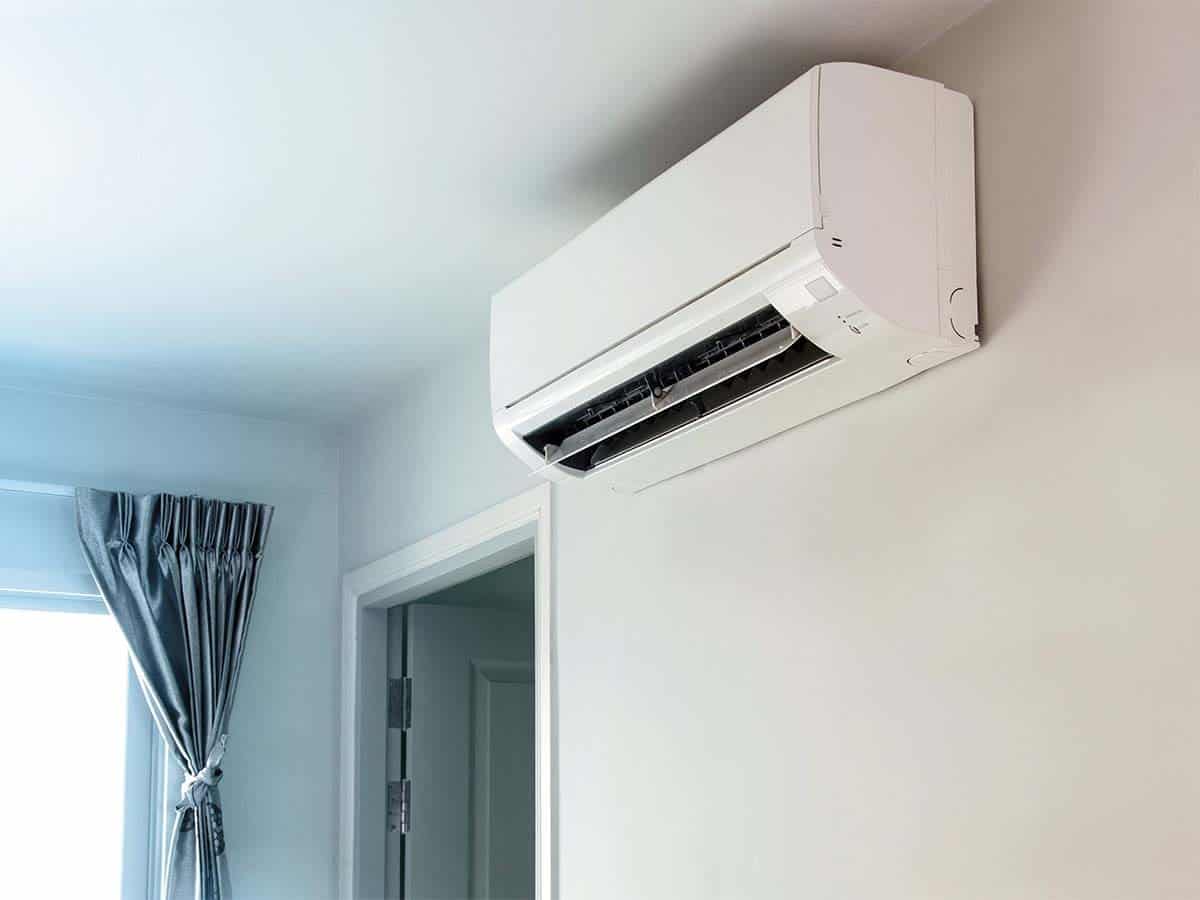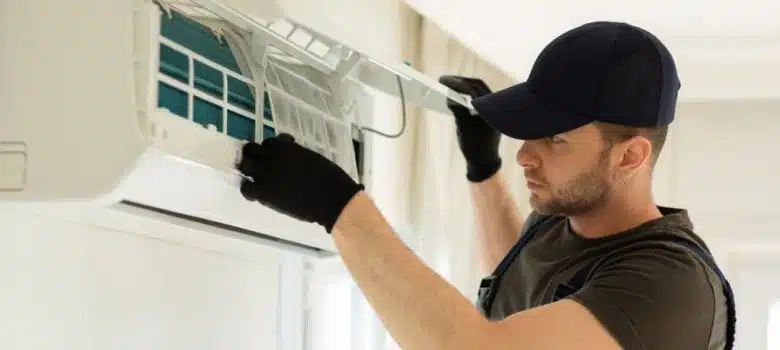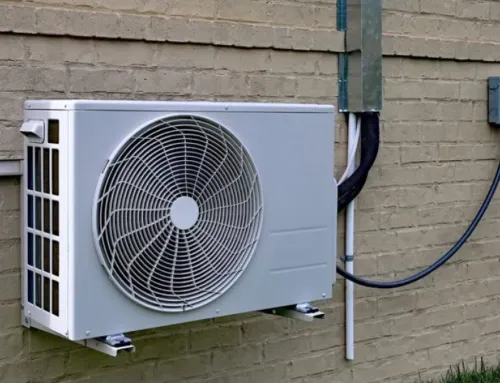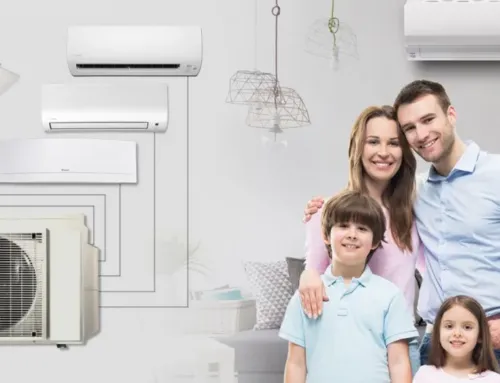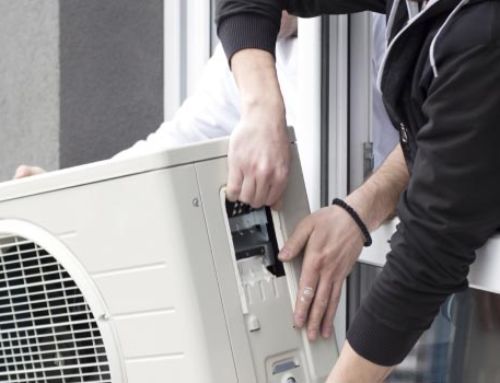The word ‘split-system’ seems quite futuristic and scientific. But you’ve actually seen these air cons everywhere!
A split-system AC is one where the larger part of the system is kept outside and the quieter unit that distributes air is kept inside. The refrigerant flows between the two systems through internal pipes and cables, resulting in the cooling or heating of the air.
This article explores the split air conditioner cost so you know exactly how much you should be paying. This is a matter of increased concern if you’re purchasing multiple units.
What is a split air conditioner?
The way that AC units work is by changing a gas to a liquid and back to a gas again. The air starts off as low pressure gas. When pressurised, it becomes a liquid. Finally, it goes through the condenser and becomes a gas yet again where it loses pressure and becomes cold. The cycle repeats itself over and over.
In sum, air is pulled from the room, goes from liquid to gas (colder air), and is expelled from the front of the AC. The room gradually becomes colder until a given temperature is reached. The system will shut off when the desired temperature is attained. This method is how the majority of AC units operate.
The word ‘split’ indicates that the larger part of the AC unit is held in a different area. This can be contrasted to the other unit types such as ducted or portable air conditioning devices. More information on these units is given later in this article.
The benefits of a split air conditioner
There are many reasons that the split-system is one of the most popular. Here are just a few of their benefits:
#1 – Ease of installation
While you will still need to work with a registered professional for installation, split-systems are actually quite straightforward to get up and running. Both the indoor and outdoors units are set in place and then connected with internal pipe mechanisms.
#2 – Energy efficiency
Split-system AC units are automatically designed so that little to no energy is wasted. There are various degrees of thermal efficiency, and each unit needs to be individually assessed. However, these units are generally efficient in their mode of operation.
#3 – Cost
Split-system air conditioner units are very cost effective, though there is again quite a range here. The cost can vary from $800 – $2,800 depending on brand name and size. You’re going to have to weigh the cost of the initial investment against the efficiency of the unit. The more efficient the unit, the lower your electricity bill will be each year.
#4 – Low noise levels
Split-system AC units are very quiet. This is a huge benefit when you take account of the fact that they are to run for much of the day, especially in warm climates. They are typically quieter than ceiling fans, and a loud split-system is often a sign of a malfunction that you should have addressed sooner rather than later.
#5 – Aesthetic appeal
Most split-system systems fit in well with their surroundings. They are often white and sleek in design. They are often seen in fancy restaurants because they do not detract from the design or function of the space.
#6 – Flexibility
A split-system AC unit can be installed in any single room. This adds to their energy efficiency and makes them cheaper to install since you can add them as needed. You might only need one particular room cooled or heated. Of course, you can also set the exact temperature and when you want the system to turn on using a remote.
What does a split air conditioner cost?
There are many variables to take into account in terms of the split air conditioner cost. Below, the pricing table can give you a better idea. Keep in mind that the table is for supply only. Installation costs are separate.
You might also want to consider the cost of running the split-system AC unit: approximately $0.20 to $0.40 per hour. In contrast, a ducted whole house unit will cost far more at $2.50 to $4.00 per hour. The total cost of running the unit will depend on the cost of electricity in your area, the efficiency of your system, and the number and size of rooms to be heated or cooled.
| Size of Room | Capacity | Price Range |
| 10m2 – 25m2 | 2.5kW | $800 – $1,200 |
| 25m2 – 35m2 | 3.5kW | $1,000 – $1,600 |
| 35m2 – 60m2 | 5 – 6kW | $1,400 – $2,200 |
| 60m2 – 85m2 | 7 – 8.5kW | $1,600 – $2,400 |
| 85m2 – 95m2 | 9 – 9.4kW | $2,200 – $2,800 |
What is split air conditioner cost in terms of installation?
The cost of split-system air conditioner installation varies. Purchasing the AC unit is one thing, but installation costs are something entirely different. The typical hourly rate for a qualified installer is between $60 – $80 per hour. All things going well, the system should take between 4 – 8 hours to be installed properly.
If installation lasts 12 hours or beyond, the cost will quickly add up and could potentially double the price you expected to pay for the AC unit alone. You could wind up paying $1600 or more for the installation, so make sure to query your service provider. The factors that affect the installation cost by prolonging the total time taken will include:
- Site access
- Pipe
- Cabling
- Electrical infrastructure
- Location of the outside unit
- Type of the split-system unit
- Size of the split-system unit
- Additional services (such as switchboard upgrade)
There are three different trades that could potentially install an AC split-system: electricians, plumbers, and specialist AC installers. Anyone handling your AC unit must have a licence to handle refrigerants. Make sure they have one before hiring.
Just how efficient are split-system air conditioners?
They are extremely efficient: 300% – 600%. This means that every one unit of electricity can be converted into 3 – 6 times as much heat or cooling energy. Air con units use gas instead of electricity, and this works out far more cheaply. Split-system air conditioner prices are often a reflection of the efficiency of the system.
The majority of AC units use reverse cycles, meaning you will be warmer in winter and colder in summer. Reverse cycle simply means that the unit is able to produce both hot and cold air. The same refrigerant coolant is used to both heat and cool the gas.
If you have any questions regarding the efficiency of split-system AC units, installation queries, or want further information on the best long-term solutions, contact HunterCON now on 02 8283 1105 for fast and free quotes.
How can I gauge the efficiency of split-system air conditioners?
Actually, this can be a lot more difficult than you would expect for various reasons. Australia uses a Zone Energy Label Rating (ZERL). You will find this rating on all units distributed after April 2020. The ZERL label will have a capacity output and a power input out for both the cooling and heating functions. Both are measured in kW.
The efficiency of a given unit will also be determined by your zone. The three major zones are Hot (Brisbane, Darwin, Pacific Islands), Average (Adelaide, Perth, Sydney), and Cold (Hobart, Melbourne, Canberra). The good news is that all of these metrics are gauged using a total of 10 stars. The more stars, the better. This can give the consumer a good idea of energy efficiency without having to figure out the pure kW metrics.
The ZERL rating also displays the noise levels of both the indoor and outdoor units in decibels. Portable AC units now have to display a rating though ducted units do not have to. ZERL uses a star-rating system based on the annual energy efficiency ratio (AEER) and the annual coefficient of performance (ACOP) for a given zone.
How can I select the right split-system AC unit for my home?
Using the ZERL ratings that must be displayed on split-system units, you can figure out the right AC unit for your home. Take into account the following factors:
Climate Zone
To make the best use of the labels, you will need to first see what region you are in. You can then see how efficient the model is for your exact location.
Capacity
Perhaps the most misunderstood metric, the size of the air conditioner does not really matter. Units of the same size can have vastly different capacities. The larger the room, the more capacity you will need. Sometimes, the word ’size’ is used to indicate ‘capacity,’ which can be confusing to customers.
Noise
You will want to find a split-system air conditioner that has the lowest noise levels possible. This is important, especially if the outdoor unit is near to a neighbour’s house or a window. Most models are pretty quiet.
Price
This is actually a secondary consideration. Because you need a particular model with a given capacity to cool or heat a room, the price will reflect this. There is little point having a powerful AC unit to heat or cool a small room. The cost table we provided should prove very useful so you can gauge what split-system unit is most appropriate and the range you can expect to pay.
Choose most efficient and effective air conditioner option for your home
Split-system air con units, in tandem with multi-split systems, are the most energy efficient and cost effective solutions for the majority of Australian homes and commercial establishments.
To find out which one is right for you and what it will cost, you need to gauge the size of your room(s) and select a unit with an appropriate heating and cooling capacity. You also want to take into account the ZERL rating. A range of models will be available to match your energy requirements.
Remember that AC units are built to last despite the costs and many come with strong warranties. With regular maintenance, a split-system should last 15 years or more, though it will vary depending on the level of usage. It’s a great investment, provided you do your research and choose the right one for your home.
For more information on split-systems, contact HunterCON. We can save you quite a lot of time and a fair amount of the cost. We know all too well that the ever-changing regulatory labels can be confusing. With nearly 10 years of dedicated experience, we can cut through the jargon so you have a thermally efficient home with a perfect installation at the perfect price.
Call now on 02 8283 1105 for a fast, free, and no-nonsense quote.


